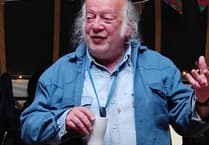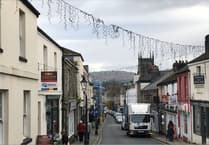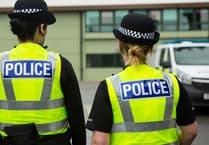AN INTERPRETATION panel has been installed opposite the statue of Tavistock’s most controversial historical figure Sir Francis Drake giving a fuller picture of his life including his links to the slave trade.
The panel on Plymouth Road, a project led by Tavistock Town Council, was developed after the town’s famous seafarer became caught up in the protests calling for statues and monuments of historical personalities involved in slavery to be removed.
It followed the police killing of George Floyd in Minneapolis which set off mass protests across the United States and fuelled movements against racism in Europe and other parts of the world.
In Tavistock, the debate whether Drake, who was largely responsible for saving England from invasion in the 16th century but also dabbled in the slave trade, should continue to be celebrated with a statue at the entrance to the town dominated the local news.
‘With everyone locked in because of the covid pandemic, it was a very difficult time but it was important to understand the issue from all different perspectives and we spoke to many residents about the topic,’ said Cllr Ursula Mann, one of three councillors appointed to work on the project.
To get a clearer idea of residents’ views, the town council carried out a survey alongside a pupils’ and parents’ questionnaire with Tavistock College about Sir Francis Drake and the statue. The majority view was that the statue should remain but there should be a clear explanation as to exactly how Drake had become involved in 16th century slave trading.
The town council reached out to the Tavistock Heritage Trust (THT) for support. The Trust was able to obtain a grant from Historic England to not only create an interpretation panel but also to fund the creation of a school’s education programme with lessons covering the story of Sir Francis Drake, the history of the slave trade and the horrors of modern day slavery.
The council and heritage trust continued to develop both the text and design for the information panel after consultation with local groups and historians whilst also working with One Bristol Curriculum and Tavistock College to develop the schools’ programme.
Despite being delayed by covid and lockdowns the schools’ programme was finally completed this summer ready to be incorporated into the school’s curriculum for the autumn term.
Assistant principal of Tavistock College Nick Read has been integral in the implementation and development of the Drake Schools Project and he is delighted with the finished project.
‘The schools programme will help us to educate the students around the story of Sir Francis Drake and to develop our understanding of how past events should inform our current and future behaviours and attitudes.’
His sentiments were echoed by Guy Ayling principal of Mount Kelly ‘This is a significant initiative and a meaningful response to pressing issues in society,’ he said.
Historic England will be distributing the lessons via its Devon Heritage Schools programme.
Historic England’s local heritage education manager South West Michael Gorely said: ‘The resources created for the schools programme will not only benefit Tavistock schools, we are keen for them to be used by schools across the county to support children’s understanding of how the Transatlantic slave trade impacted on Devon.’
Rotary International will also be distributing the schools’ programme across the UK via its new Rotary for Slave Free Communities initiative.
Tavistock Rotary president Martin Webb said: ‘Rotary International has been involved in raising awareness of the issues surrounding modern slavery for several years and education is also a key aspect of our community work.’
The interpretation panel tells the story of Francis Drake’s career including his early slave trading expeditions with his cousin John Hawkins. It also tells the story behind the erection of the statue in 1883.
Dr Geri Parlby, chair of THT said: ‘It was very important to us that we presented a measured and accurate precis of the history of Sir Francis Drake. It is impossible to capture the full story of his life on one panel which is why we have provided a QR code to take people to other sites where they can learn more about both the man himself and the story of the transatlantic slave trade.’
Tavistock mayor Paul Ward said: ‘Sir Francis Drake is best known for his voyage around the world and his role in contributing to the defeat of the Spanish Armada.
‘More recently his involvement in the early slave trade has become better known.The resultant controversy threatened the future of Drake’s statue on Plymouth Road, with calls for it to be removed.
‘Tavistock Town Council resolved to keep the statue in place but to present a balanced account of Drake’s career, including his involvement in early slavery and piracy.
‘Members of the town council, the Tavistock Heritage Trust, the Tavistock Rotary Club, and students and staff of Tavistock College and Mount Kelly College, with financial assistance from Historic England, collaborated in a non-judgemental and historically rigorous way to not only produce an information board and links to further information but also an educational programme for school students that recounts Drake’s history, good and bad, and puts it into a modern context.
‘On behalf of the council, I wish to thank and commend all those who have worked together as a team to achieve this admirable goal.’
Although the bronze statue has stood at the end of Plymouth Road since it was erected in 1883 after being paid for by Hastings Russell the 9th Duke of Bedford there has never been an information board explaining the connection between Tavistock and the famous Tudor sea captain, who is said to have been born on a farm at nearby Crowndale.
Having viewed the now completed panel Sir Geoffrey Cox MP admitted that he had had his concerns at how Sir Francis Drake would be portrayed.
‘Sir Francis Drake is a hero for being the first Englishman to sail right around the world, and he played a major part in defending England from the Spanish Armada. Having read the information panel, I’m satisfied that it gives a balanced and objective summary of his life and character.’
For safety reasons the panel has not been erected by the statue itself which stands in the middle of the busy roundabout. It has instead been installed on the wall opposite to enable passers by to have a chance to read, learn more and come to their own conclusions about the life and times of Tavistock’s most controversial historical figure.


-and-Sally-Ann-(visitor-experience-officer)-trying-ou.jpeg?width=209&height=140&crop=209:145,smart&quality=75)


Comments
This article has no comments yet. Be the first to leave a comment.